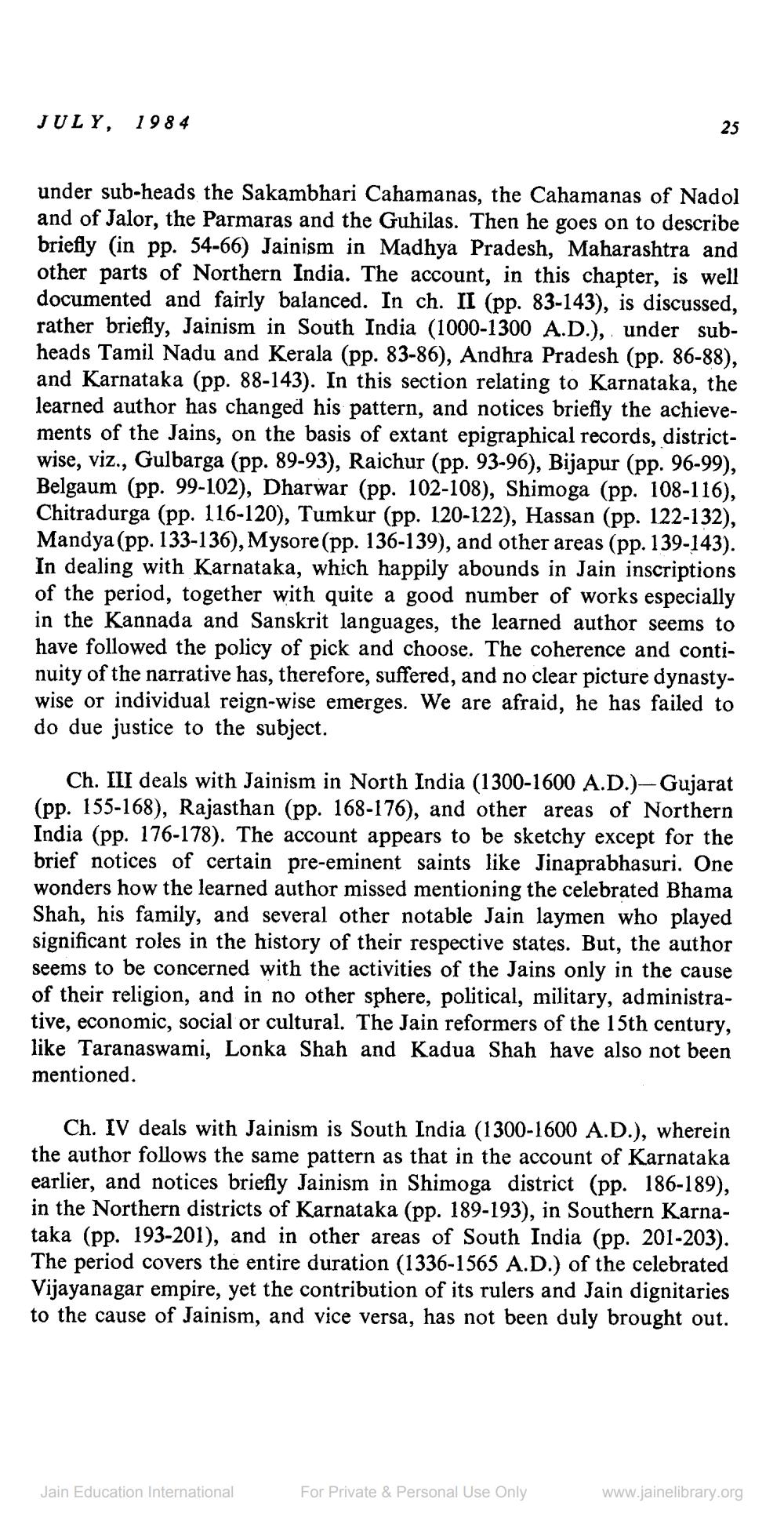Book Title: Jain Journal 1984 07 Author(s): Jain Bhawan Publication Publisher: Jain Bhawan Publication View full book textPage 4
________________ JULY, 1984 under sub-heads the Sakambhari Cahamanas, the Cahamanas of Nadol and of Jalor, the Parmaras and the Guhilas. Then he goes on to describe briefly (in pp. 54-66) Jainism in Madhya Pradesh, Maharashtra and other parts of Northern India. The account, in this chapter, is well documented and fairly balanced. In ch. II (pp. 83-143), is discussed, rather briefly, Jainism in South India (1000-1300 A.D.), under subheads Tamil Nadu and Kerala (pp. 83-86), Andhra Pradesh (pp. 86-88), and Karnataka (pp. 88-143). In this section relating to Karnataka, the learned author has changed his pattern, and notices briefly the achievements of the Jains, on the basis of extant epigraphical records, districtwise, viz., Gulbarga (pp. 89-93), Raichur (pp. 93-96), Bijapur (pp. 96-99), Belgaum (pp. 99-102), Dharwar (pp. 102-108), Shimoga (pp. 108-116), Chitradurga (pp. 116-120), Tumkur (pp. 120-122), Hassan (pp. 122-132), Mandya (pp. 133-136), Mysore (pp. 136-139), and other areas (pp. 139-143). In dealing with Karnataka, which happily abounds in Jain inscriptions of the period, together with quite a good number of works especially in the Kannada and Sanskrit languages, the learned author seems to have followed the policy of pick and choose. The coherence and continuity of the narrative has, therefore, suffered, and no clear picture dynastywise or individual reign-wise emerges. We are afraid, he has failed to do due justice to the subject. 25 Ch. III deals with Jainism in North India (1300-1600 A.D.)-Gujarat (pp. 155-168), Rajasthan (pp. 168-176), and other areas of Northern India (pp. 176-178). The account appears to be sketchy except for the brief notices of certain pre-eminent saints like Jinaprabhasuri. One wonders how the learned author missed mentioning the celebrated Bhama Shah, his family, and several other notable Jain laymen who played significant roles in the history of their respective states. But, the author seems to be concerned with the activities of the Jains only in the cause of their religion, and in no other sphere, political, military, administrative, economic, social or cultural. The Jain reformers of the 15th century, like Taranaswami, Lonka Shah and Kadua Shah have also not been mentioned. Ch. IV deals with Jainism is South India (1300-1600 A.D.), wherein the author follows the same pattern as that in the account of Karnataka earlier, and notices briefly Jainism in Shimoga district (pp. 186-189), in the Northern districts of Karnataka (pp. 189-193), in Southern Karnataka (pp. 193-201), and in other areas of South India (pp. 201-203). The period covers the entire duration (1336-1565 A.D.) of the celebrated Vijayanagar empire, yet the contribution of its rulers and Jain dignitaries to the cause of Jainism, and vice versa, has not been duly brought out. Jain Education International For Private & Personal Use Only www.jainelibrary.orgPage Navigation
1 2 3 4 5 6 7 8 9 10 11 12 13 14 15 16 17 18 19 20 21 22 23 24 25 26 27 28 29 30 31 32 33
